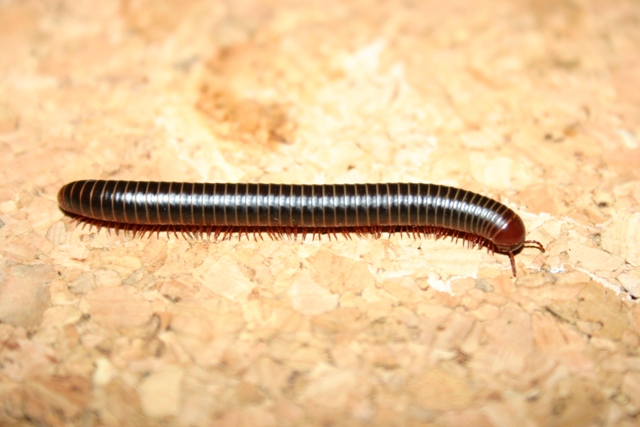Phylum Arthropoda
Subphylum Myriapoda
Class Diplopoda
Order Spirobolida
Common name: spirobolid millipedes
Overview
This order is distinguished by the presence of distinct pleurites on each body segment, just above the legs, and a pronounced suture that runs vertically down the front of the head. Both pairs of legs on the seventh segment of the male are modified into gonopods. Spirobolidans are smooth, cylindrical millipedes with 35-60 body segments in adults. They can be distinguished from similar-looking spirostreptidans by the number of legs: spirobolidans have one pair on each of the first five body segments, two pairs on succeeding segments. They possess repugnatorial glands that produce defensive secretions, such as benzoquinones and hydroquinones, that may irritate and stain the skin. Species are often large and conspicuous, and sometimes brightly coloured and patterned.
Distribution and Diversity
The order Spirobolida is a species-rich order, with more than 1200 species described from the sub-Saharan Africa, Southeast Asia and Australia. Taxonomically, it is a relatively neglected group with only two revised families, and both revisions dating back more than 40 years.
In Australia, spirobolid millipedes are mainly tropical and sub-tropical but extend to Victoria along the eastern coast. There are 3 families, 12 genera and 35 species described from Australia.
Life cycle
Spirobolids have both pairs on legs of the seventh segment modified into gonopods, which are used during sperm transfer into the gonopore of the female. Eggs are laid into soil or detritus. Newly emerged young possess three pairs of legs. Development is gradual and gonopods are first formed during several nymphal stages and molts preceding the final adult form. Growth, and therefore moulting, continues through adulthood, and their life span is typically several years.
Feeding
Spirobolid millipedes are detritivores, feeding on decaying vegetable matter.
Ecology
Spirobolids are mainly tropical and sub-tropical and occur in moist forested regions. They are usually found under logs or in leaf litter.
.jpg)
Spirobolida from Middle Springs, Western Australia
Image credit: Photographer: Mark Harvey
� Western Australian Museum

Spirobolida from Middle Springs, Western Australia
Image credit: Photographer: Mark Harvey
� Western Australian Museum
.jpg)







